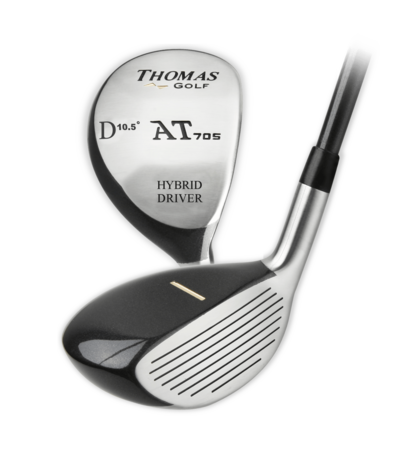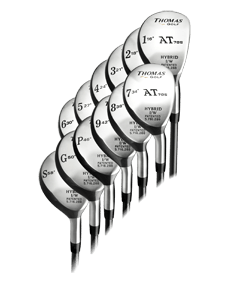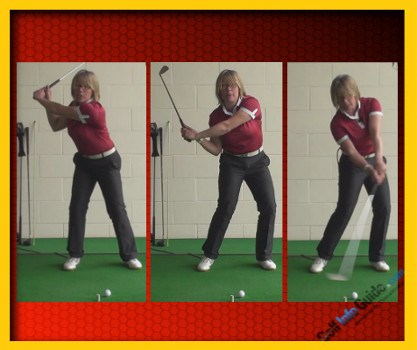
During the setup phase of your golf swing, with a normal iron club, you should feel that your body weight is equally distributed between your feet. This 50-50 weight distribution, however, is not maintained during the swing. During the backswing phase of your golf swing, you should feel how your bodyweight moves towards your rear foot. This allows the building up of power during the backswing.
At the top of the backswing, you should feel around about 60% of your bodyweight is on your rear foot and your body is coiled ready to produce a powerful downswing action. Your bodyweight will now shift towards your front foot so that at impact you have around 60% of your bodyweight over your front foot as you strike a golf ball. This, however, does not mean that every part of your body is leaning to the front foot at impact.
If you see a freeze frame picture of the world's best players at impact, you will notice they have quite a backwards leaning appearance to the upper body, with the head staying well behind the ball through the impact stage. This allows them to clear their lower half out of the way and generate a very powerful turning action through the golf ball. Their head will finally move beyond the position of the ball well after impact.
If you feel like your upper body moves too quickly in front of the golf ball during the downswing, this will result in a swaying action and may cause a lack of power and inconsistent, inaccurate golf shots. In order to maintain a good position for impact, focus on allowing your head to move over your rear knee during your backswing and then stay above your rear knee during the start of the downswing phase. This should result in a reduction of your upper body sway.
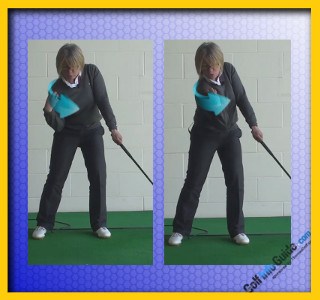
How and Why You Should Stay Behind the Golf Ball During the Swing and at Impact
A lot of golf instruction talks about how to get behind the ball on the back swing and then on staying behind the ball until after impact. Beginning with the set up your body should be positioned so that it gives you the chance to build momentum on the backswing and then unleash that power in a balanced, powerful position at impact.
There needs to be a separation between the upper and lower body at impact so that the lower body can turn ahead. When the lower body turns ahead it leaves in its wake the coiled resistance of the upper body and the finally the trailing kinetic energy that will be transferred as a result.
In reality, at impact the head is the only thing that is further back from the ball than where it began at address. Everything else will have moved more forward at impact from where it started.The shaft is leaning more forward. The hands are more forward. The shoulders have turned opened (if not tilted) and the hips will have turned forward about twice as much as the shoulders.
So, how and why does it work this way?
First, you have to get behind the ball in order to stay behind the ball. If you over swing, reverse pivot, have an abbreviated shoulder turn or if your head tilts left during the backswing then you have never really gotten behind the ball. These backswing issues could make it difficult to get into an impact position so that you are behind the ball.
During the backswing you need to get into a balanced position with your weight located where it can be transferred quickly and efficiently at impact. While at impact the upper body needs separation from the lower body so that the arms have room to extend. The body will move in response to what the arms are doing. The head will move back and down slightly to allow maximum extension at and through impact.
In order to apply maximum force the left leg will lock and the left arm will lock. The right arm is still slightly bent and the abrupt locking of the left side will cause the angles in the right elbow and wrist to straighten. The force will also cause the right shoulder to work under, the head to drop and the arms to extend down the target line.
During the downswing the speed of the club, arms and hands increases as head moves down and away because the lower body is moving forward. As the left leg and left arm lock the upper body will then start to slow down and then transfers energy quickly which speeds up the club.
If the head position were to change and instead move ahead of the ball, the kinetic energy illustrated above would be released much later. The energy released at impact would be much less and this is why you need to stay behind the ball during the swing and at impact. You want maximum energy released at impact.
Staying behind the ball will ensure that you get the highest yield in terms of power from your efforts. It also will enable you to return the clubface to a square position and that benefits you with not only more solid shots, but straighter shots.
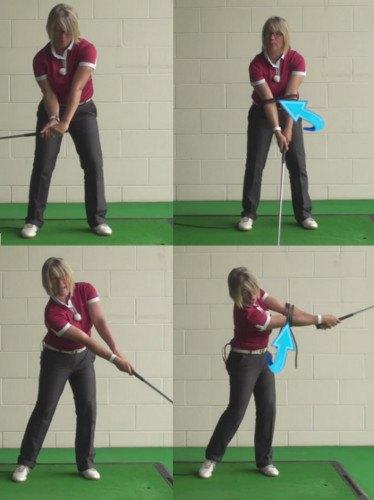
Are You Staying Behind The Ball at Impact?
There are time when you get so far out in front of a shot that it feels like you have just grazed the ball with your club. It feels like a wasted shot. Weak. No power. It usually goes to the right, but sometimes you start getting frustrated and you throw the club over the top on the downswing just so you can get a nice solid pull.
Have you ever experienced this? Sure you have. You aren't behind the ball at impact and you don't have power and you don't have good contact. It feels terrible.
Another sign you might be ahead of the ball at impact is if you are hitting the dreaded pop-up drives. Contrary to logical thinking, pop-ups are typically caused when your head is in front of the ball and your left shoulder is lower than your right. It causes a very steep angle and very high shot.
Here are a few drills that will help you diagnose if you are staying behind the ball at impact. If you are not staying behind the ball it is possible your shots will feel off center and weak. Use these drills to get you back on track so that you can start hitting more solid, powerful shots.
2x4 Drill
- Set up as if to hit a shot.
- Take a stance with the long end of the 2x4 in front of your club face pointing down the target line.
- Slowly push the long end of a 2x4 with your club towards the target.
- Check to make sure the back of your left hand is flat and your right hand is slightly bent.
- The lower body should be turning with your right foot pushing off of the ground.
- IMPORTANT- Make sure the right shoulder is lower than the left and your head moves back slightly. This should straighten your left arm in line with the shoulder.
Head Against the Wall drill
- Without a club, set up next to a wall so that your head very lightly touches a wall.
- Swing back and through past impact
- Pay attention to your posture and head movement.
- You should not stand up or move forward with your head
- As the backswing is made, you can feel the majority of your weight moving to the back foot, while the head is remaining still against the wall.
- On the forward swing, a golfer can feel the weight moving towards the target, while the head is still staying behind the golf ball. This is the swing point the golfer needs to understand. The body moves to the target, while the head is staying behind the line formed from the golf ball extending straight upwards. The line will be between the ball and the golfers head.
This is an on-course drill to help you make a correction during the round. If you are in the middle of a round and hitting several glancing blows that are going high and right, an adjustment needs to be made.
- Go to your golf cart.
- Place your trail hand (right hand for the right handed golfer) against the back of the passenger seat on the golf cart.
- The cart seat should be even with the instep of your front foot.
- Make sure your palm of your hand is flush against the golf cart seat, while taking your athletic golf stance.
- Put your left hand, or target hand behind your back. Make your backswing and feel the weight moving and coiling back to your right sid
- You might feel your right hip coil over top your right heel. Make a forward uncoiling motion to the golf cart seat. Let your palm hit firmly against the back of the golf cart seat. As the palm making a loud smack against the golf cart seat, check your balance. You should feel your head still behind the golf cart seat, as your body is uncoiling towards the target. This is the impact position you should strive for.
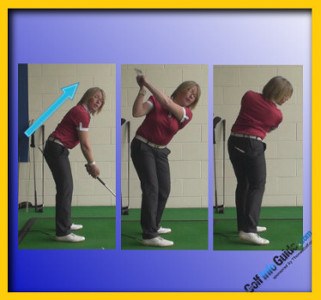
Keys to Help You Get Behind the Ball at Impact
Getting behind the ball at impact is facilitated by a good backswing. Start with a good set up that makes it easy for you to get a good turn and your weight transfer will be elementary. Try to keep your movements simple and remember that you can gain power by saving energy and making your movements controllable and balanced.
Exactly how you get behind the ball to begin with is pretty simple. The fact is that if you set up behind the ball, the task of swinging back and getting behind the ball is half done. Here are a couple of things you can do to ensure you are setting up behind the ball. Clap your hands then slide the right hand and shoulder below the left. If your neck feels tight, let your neck fall to the right a little. This position sets you up so that your head is behind the ball and your weight favors your right side.
Another set up tip for someone that has trouble getting behind the ball on the backswing is to flare your right foot slightly or to pull it back slightly. This should add a little more weight to your right side without having to actually lean in that direction.
The setup, or stance is key in helping a person have a successful shot with while staying behind the ball. If a golfer has trouble staying behind the ball start by looking at your stance.
Most golfers start off with a 50/50 weight distribution between their lead (left foot for the right handed golfer) and trail foot (right foot for the right handed golfer). There are many successful players that set up with 60% of their weight on their right side.
Another key to check your spine angle at the stance. The spin angle is almost identical to the buttons on the front of a golf shirt. If the player sets up with the weight 50/50 between the right and left foot, then as the golfer slides their right hand down below the shoulder as stated above, they will feel additional weight move to the right side during set up. The shirt buttons and spine move a few degrees away from the target. Then move just a bit more to the right to help set up even more behind the ball. The additional adjustment is to 'bump' the front hip towards the target a two or three inches. As the front hip is 'bumped' towards the target, the shirt placket will lean even further to the right of the target, or lean further away from the target. It will be setting the body up for an explosive forward swin
The backswing is a very important part of the golf swin
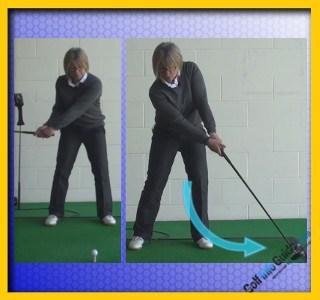
Keys to Help You Stay Behind the Ball at Impact
It is crucial that you stay behind the ball at impact in order to transfer the energy you have built up in your backswin
Additionally, it is important that the left side of the body has not broken down and gotten too far ahead at impact. For instance, if the left arm is bent at impact then the shoulder, elbow and wrist joints will not align at impact. The breakdown will not allow for a transfer of energy from the body to the club. On video it will appear as though the elbow is well ahead of the ball at impact. The same can be said for the left knee if it were to be bent at impact.
Another indicator that you are not behind the ball at impact is your shoulder position. If your shoulders appear to be level at impact then despite what you may feel it is very difficult for the head to be behind the ball at impact. The right shoulder should be lower than the left shoulder which allows for a full extension of the arms down to the ball and then the target line.
Here are some tips to get your body in the right position at impact so you can stay behind the ball.
Start the downswing with the lower body
- The motion caused by your lower body beginning the downswing accomplished two crucial tasks in helping you stay behind the ball; first, it helps drop your right shoulder. Second, it begins the movements that will start to straighten your left side for impact. The right side goes down and the left side goes up.
- A good swing thought is to start the downswing by pressing your right heel off of ground toward the toes of your left foot. This will force your weight shift from down to up making your left hip go up and left leg straighten, while the right shoulder will want to go down.
Swing between your feet.
- Take some short, abbreviated swings while making sure that your weight never goes outside.The edges of your feet. Plant your hip bones squarely over your heels to help you feel the balance and control of your weight shift.
- Now increase your swings, still keeping the swings between your feet.
- Every 3rd swing take a very long swing. Try to feel how difficult it is to recover from swinging outside your feet
- Go back to the shorter swings making sure you swing between your feet. Maximum power also means maximum control.
- Many golfers rotate their shoulders early from the top of their swing. This can cause an early release and a weak shot. In my opinion, the biggest reason for this is that you never really turn behind the ball on the backswing. If the weight hangs on the left side at the top of your swing, you are likely to start your downswing with an early unwinding of the shoulders and torso from the top of the swing.

Drills That Will Help You Stay Behind the Ball During the Swing and at Impact
Step Forward Drill
This drill does not involve a backswing. You will need to hit the ball while only swinging forward, concentrating on keeping your head behind the ball.
- Tee up a ball.
- Set up to the ball with your feet together. The ball position should be outside your left shoulder.
- Step forward with the lower body.
- While the lower body moves forward, allow it to pull the right shoulder down.
- Swing down and through to the finish.
Club against the wall drill
- Using a wall outside, set up with your back to the wall.
- Back up so that your rear end is barely touching the wall.
- Swing back slowly to the top of your swing and hold your position
- While holding the top half of your body still, start slowly turning the lower body.
- Continue to turn the lower body slowly, only letting the upper body respond to the pull of the lower body until you read impact position.
Cane Drill
- Select a mid-iron from your bag
- Turn the club upside-down
- Place your left hand on top of the club
- Bend over like you were going to hit a shot. The left arms should be straight out from the left shoulder, left hand on top of the club.
- The right arm should be hanging straight down.
- Swing back and then swing under the left arm, letting the contact stop your swing.
- This drill should force your right shoulder under and your head to stay back. At the same time it solidifies your left side while allowing the right to continue to turn.
Preview Drill
- Take your address with an iron, and then mimic a good impact position.
- Push the handle forward, shift your weight to your front foot, and get up on the toes of your back foot.
- Your hips should be open but your chest facing the ball.
- Go back to address then repeat drill position when you swing.
Tilt Again Drill
- This drill is for the golfer who is very much struggling with staying behind the ball because of over swinging or loss of posture at the top of the backswing.
- Take a normal backswing and hold your position momentarily.
- Before starting the downswing with your lower body, tilt your spine slightly to the right.
- Now start your downswing with the lower body, holding your upper body back.
- You will still feel the lower body pull the right shoulder under, giving you a tilt “again”
Drag it through
- This drill will make you wait for the clu
- You will resist the urge to slide ahead of the ball and will be able to keep your head behind the ball until after impact.
- Set up to the ball normally.
- Take a normal backswing and hold your position.
- Drop your arms straight down so that the club head hits the ground.
- Turn your lower body and drag the club through, taking care to keep the club shaft pushed forward and your head back.


